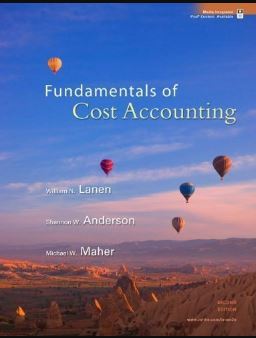
Fundamentals of Cost Accounting 2nd Edition by William Lanen, Carolyn Wells, Michael Maher
Edition 2ISBN: 978-0077274993
Fundamentals of Cost Accounting 2nd Edition by William Lanen, Carolyn Wells, Michael Maher
Edition 2ISBN: 978-0077274993 Exercise 13
Plantwide versus Department Allocation
Munoz Sporting Equipment manufactures baseball bats and tennis rackets. Department B produces the baseball bats, and Department T produces the tennis rackets. Munoz currently uses plantwide allocation to allocate its overhead to all products. Direct labor cost is the allocation base. The rate used is 200 percent of direct labor cost. Last year, revenue, materials, and direct labor were as follows:

Required
a. Compute the profit for each product using plantwide allocation.
b. Maria, the manager of Department T, was convinced that tennis rackets were really more profitable than baseball bats. She asked her colleague in accounting to break down the overhead costs for the two departments. She discovered that had department rates been used, Department B would have had a rate of 150 percent of direct labor cost and Department T would have had a rate of 300 percent of direct labor cost. Recompute the profits for each product using each department's allocation rate (based on direct labor cost).
c. Why are the results different in requirements ( a ) and ( b )
Munoz Sporting Equipment manufactures baseball bats and tennis rackets. Department B produces the baseball bats, and Department T produces the tennis rackets. Munoz currently uses plantwide allocation to allocate its overhead to all products. Direct labor cost is the allocation base. The rate used is 200 percent of direct labor cost. Last year, revenue, materials, and direct labor were as follows:

Required
a. Compute the profit for each product using plantwide allocation.
b. Maria, the manager of Department T, was convinced that tennis rackets were really more profitable than baseball bats. She asked her colleague in accounting to break down the overhead costs for the two departments. She discovered that had department rates been used, Department B would have had a rate of 150 percent of direct labor cost and Department T would have had a rate of 300 percent of direct labor cost. Recompute the profits for each product using each department's allocation rate (based on direct labor cost).
c. Why are the results different in requirements ( a ) and ( b )
Explanation
A sporting company produces baseball bat...
Fundamentals of Cost Accounting 2nd Edition by William Lanen, Carolyn Wells, Michael Maher
Why don’t you like this exercise?
Other Minimum 8 character and maximum 255 character
Character 255


